1977 Bruxelles Salon International Vehicules Utilitaires
Page 37
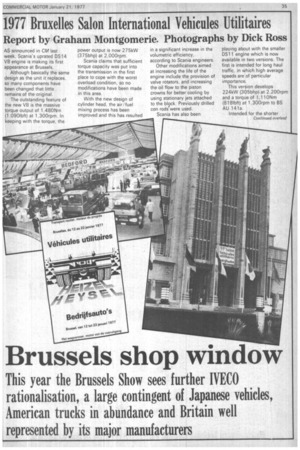
Page 38
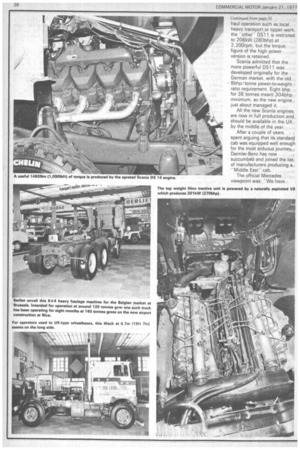
Page 39
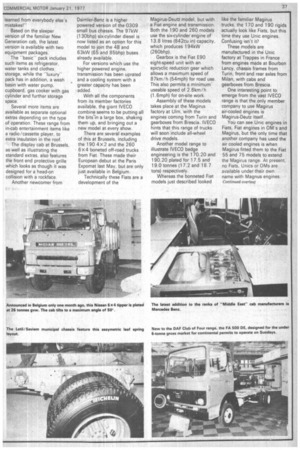
Page 40
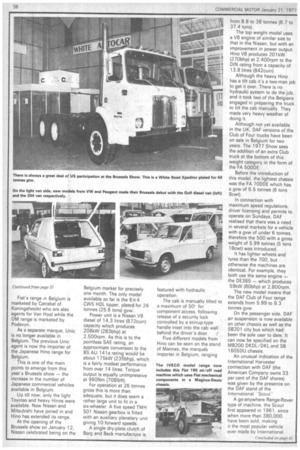
Page 45
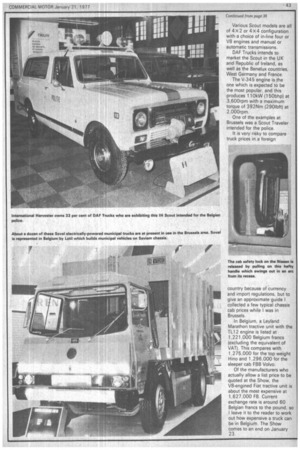
If you've noticed an error in this article please click here to report it so we can fix it.
Report by Graham Montgomerie. Photographs by Dick Ross
AS announced in CM last week, Scania's uprated DS14 V8 engine is making its first appearance at Brussels.
Although basically the same design as the unit it replaces, so many components have been changed that little remains of the original.
The outstanding feature of the new V8 is the massive torque output of 1,480Nm (1,090Ibft) at 1,300rpm. In keeping with the torque, the power output is now 275kW (375bhp) at 2,000rpm.
Scania claims that sufficient torque capacity was put into the transmission in the first place to cope with the worst overload condition, so no modifications have been made in this area.
With the new design of cylinder head, the air/fuel mixing process has been improved and this has resulted in a significant increase in the volumetric efficiency, according to Scania engineers.
Other modifications aimed at increasing the life of the engine include the provision of valve rotators, and increasing the oil flow to the piston crowns for better cooling by using stationary jets attached to the block. Previously drilled con rods.were used.
Scania has also been playing about with the smaller DS11 engine which is now available in two versions. The first is intended for long haul traffic, in which high average speeds are of particular importance.
This version develops 224kW (305bhp) at 2,200rpm and a torque of 1,110Nm (818Ibft) at 1,300rpm to BS AU 141a.
Intended for the shorter
haul operation such as local heavy transport or tipper work, the -otherDS11 is restricted to 206kW (280bhp) at 2,200rpm, but the torque figure of the high power version is retained.
Scania admitted that the more powerful DS11 was developed originally for the German market, with the old 8bhp/tonne power-to-weight ratio requirement. Eight bhp for 38 tonnes meant 304bhp minimum, so the new engine just about managed it.
All the new Scania engines are now in full production and should be available in the UK by the middle of the year.
After a couple of years spent arguing that its standard cab was equipped well enough for the most arduous journey, Daimler-Benz has now succumbed and joined the list of manufacturers producing a "Middle Eastcab.
The official Mercedes viewpoint was "We have learned from everybody else's mistakes!"
Based on the sleeper version of the familiar New Generation cab, the latest version is available with two equipment packages.
The -basicpack includes such items as refrigerator, water tanks and clothes storage, while the "luxury" pack has in addition, a wash basin with water pump, cupboard, gas cooker with gas cylinder and further storage space.
Several more items are available as separate optional extras depending on the type of operation These range from in-cab entertainment items like a radio/cassette player, to extra insulation in the roof The display cab at Brussels, as well as illustrating the standard extras, also features the front end protective grille which looks as though it was designed for a head-on collision with a rockface.
Another newcomer from Daimler-Benz is a higher powered version of the 0309 small bus chassis. The 97kW (130bhp) six-cylinder diesel is now listed as an option for this model to join the 48 and 63kW (65 and 85bhp) buses already available.
For versions which use the higher powered engine, transmission has been uprated and a cooling system with a greater capacity has been added.
With all the components from its member factories available, the giant IVECO combine seems to be putting all the bits in a large box, shaking them up, and bringing out a new model at every show.
There are several examples of this at Brussels, including the 190 4x2 and the 260 6x4 boneted off-road trucks from FiatThese made their European debut at the Paris Expomat last May, but are only just available in Belgium.
Technically these Fiats are a development of the Magirus-Deutz model, but with a Fiat engine and transmission. Both the 190 and 260 models use the six-cylinder engine of 13.8 litres (842cu in) capacity, which produces 194kW (260bhp).
Gearbox is the Fiat E90 eight-speed unit with an epicyclic reduction gear which allows a maximum speed of 87km/h (54mph) for road use. This also permits a minimum' useable speed of 2.6km/ h (1.6mph) for on-site work.
Assembly of these models takes place at the Magirus factory at Ulm, with the engines coming from Turin and gearboxes from Brescia. IVECO hints that this range of trucks will soon include all-wheel drive models.
Another model range to illustrate IVECO badge engineering is the 170.20 and 190.20 plated for 17.5 and 19,0 tonnes (17.2 and 18.7 tons) respectively.
Whereas the bonneted Fiat models just described looked like the familiar Magirus trucks, the 170 and 190 rigids actually look like Fiats, but this time they use Unic engines. Confusing isn't it?
These models are manufactured in the Unic factory at Trappes in France from engines made at Bourbon Lancy, chassis frames from Turin, front and rear axles from Milan, with cabs and gearboxes from Brescia.
One interesting point to emerge from the vast IVECO range is that the only member company to use Magirus air-cooled engines is Magirus-Deutz itself.
You can see Unic engines in Fiats, Fiat engines in OM's and Magirus, but the only time that another company has used the air cooled engines is when Magirus fitted them to the Fiat 55 and 75 models to extend the Magirus range. At present, no Fiats, Unics or OMs are available under their own name with Magnus engines. Continued overleap
Fiat's range in Belgium is marketed by Catrabel of Koningshooikt who are also agents for Van Hool while the OM range is marketed by Podevyn.
As a separate marque, Unic is no longer available in Belgium. The previous Unic agent is now the importer of the Japanese Hino range for Belgium.
This is one of the main points to emerge from this year's Brussels show — the increase in the number of Japanese commercial vehicles available in Belgium.
Up till now, only the light Toyotas and heavy Hinos were available, Now Nissan and Mitsubishi have joined in and Hino has extended its range.
At the opening of the Brussels show on January 12, Nissan celebrated being on the Belgium market for precisely one month. The only model available so far is the 6 x4 CW5 HDL tipper, plated for 26 tonnes (25.6 tons) gvw.
Power unit is a Nissan V8 diesel of 14.3 litres (872cuin) capacity which produces 208kW (283bhp) at 2,500rpm. As this is to the pointless SAE rating, an approximate conversion to the BS AU 141a rating would be about 175kW (235bhp), which is a fairly modest performance from over 14 litres. Torque output is equally unimpressive at 960Nm (708Ibft).
For operation at 26 tonnes gross this is more than adequate, but it does seem a rather large unit to fit in a six-wheeler. A five speed TMH 501 Nissan gearbox is fitted with an auxiliary planetary unit giving 10 forward speeds.
A single dry-plate clutch of Borg and Beck manufacture is featured with hydraulic operation.
The cab is manually tilted to a maximum of 50c for component access, following release of a security lock controlled by a stirrup-type handle inset into the cab wall behind the driver's door. ;-.• Five different models from Hino can be seen on the stand of Mannes, the marque's importer in Belgium, ranging from 8.8 to 38 tonnes (8.7 to 37.4 tons).
The top weight model uses a V8 engine of similar size to that in the Nissan, but with an improvement in power output. Hino V8 produces 201 kW (270bhp) at 2,400rpm to the DIN rating from a capacity of 13.8 litres (842cuin).
Although the heavy Nino has a tilt cab it's a two-man job to get it over. There is no hydraulic system to do the job, and it took two of the Belgians engaged in preparing the truck to tilt the cab manually. They made very heavy weather of doing it.
Although not yet available in the UK. DAF versions of the Club of Four trucks have been on sale in Belgium for two years. The 1 977 Show sees the addition of an extra Club truck at the bottom of this weight category in the form of the FA 500DE.
Before the introduction of this model, the lightest chassis was the FA 700DE which has a gvw of 6.5 tonnes (6 tons 8cwt).
In connection with maximum speed regulations, driver licensing and permits to operate on Sundays, DAF realised that there was a need in several markets for a vehicle with a gvw of under 6 tonnes, therefore the 500 with a gross weight of 5.99 tonnes (5 tons 18cwt) was introduced.
It has lighter wheels and tyres than the 700, but . otherwise the machines are identical. For example, they both use the same engine — the DE385 — which produces 59kW (80bhp) at 2,800rpm.
The new model means that the DAF Club of Four range extends from 5.99 to 9.3 tonnes gvw.
On the passenger side, DAF air suspension is now available on other chassis as well as the SB201 city bus which had been the sole user to date. It can now be specified on the MB200 DKDL/DKL and SB 1605DU chassis.
An unusual indication of the International Harvester connection with DAF (the American Company owns 33 per cent of the DAF shares) was given by the presence on the DAF stand of the International -Scout
A go-anywhere Range-Rover type of machine, the Scout first appeared in 1961, since when more than 380,000 have been sold, making it the most popular vehicle ever made by International. Various Scout models are all of 4X2 or 4x4 configuration with a choice of in-line four or V8 engines and manual or automatic transmissions.
DAF Trucks intends to market the Scout in the UK and Republic of Ireland, as well as the Benelux countries, West Germany and France.
The V-345 engine is the one which is expected to be the most popular, and this produces 110kW (150bhp) at 3,600rpm with a maximum torque of 392Nm (290Ibft) at 2,00Orpm.
One of the examples at Brussels was a Scout Traveler intended for the police.
It is very risky to compare truck prices in a foreign country because of currency and import regulations, but to give an approximate guide I collected a few typical chassis cab prices while I was in Brussels.
In Belgium, a Leyland Marathon tractive unit with the TL12 engine is listed at 1,221,000 Belgium francs (excluding the equivalent of VAT). This compares with 1,275,000 for the top weight Hino and 1,296,000 for the sleeper cab F88 Volvo.
Of the manufacturers who actually allow a list price to be quoted at the Show, the V8-engined Fiat tractive unit is about the most expensive at 1,627,000 FB. Current exchange rate is around 60 Belgian francs to the pound, so I leave it to the reader to work out how expensive a truck can be in Belgium. The Show comes to an end on January 23.


























































































































